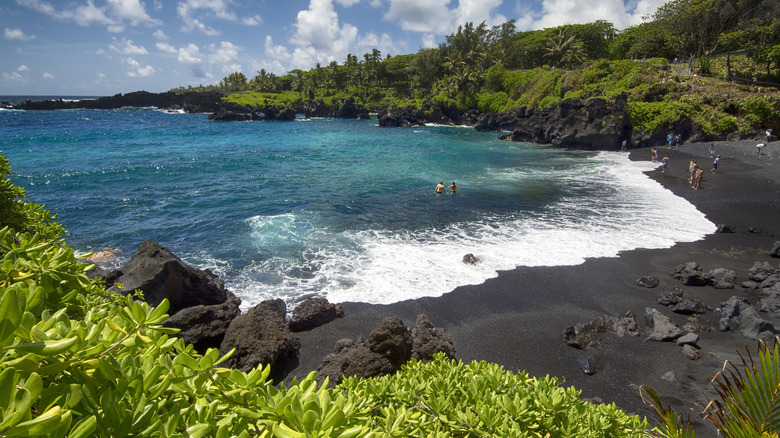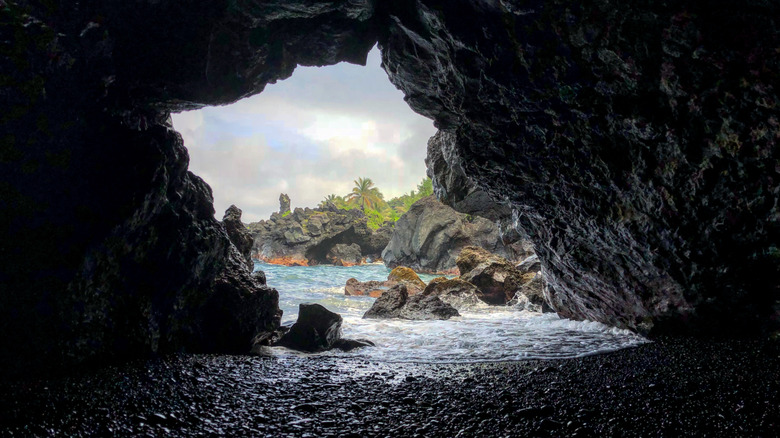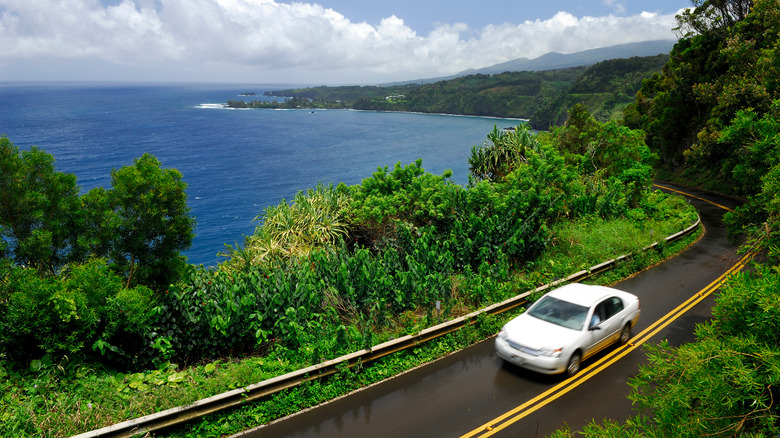Take A Stroll Along The Stunning Black Sand Beaches At This Hawaiian State Park
Hawaii, in general, is one of those postcard places — almost too beautiful to be real. But perhaps none more so than Waiʻānapanapa State Park, a protected paradise off the famous Road to Hana in Maui. Here visitors will find Pailoa, a black sand beach and matching lava coastline set against a dense green jungle and azure sea. This rare color palette can only be found in areas with high volcanic activity, as the lava and basalt rock are pummeled into pebbles and fine sand by the ocean over millennia, says the National Oceanic and Atmospheric Administration (NOAA). In other words, it's some of Mother Nature's finest work.
Beyond the black sands of Pailoa, the whole of Waiʻānapanapa State Park comprises 120 acres of wilderness that feels worlds away from the city, complete with hiking trails, a religious temple, a blowhole, lava archways, lava tubes, and a native hala forest, those iconic spiky trees found across the islands. Between the contrasting colors and unspoiled scenery, it's no wonder this region means "glistening waters" in the Hawaiian language, says the Department of Land and Natural Resources.
Things to do in Waiʻānapanapa State Park
When you arrive at Waiʻānapanapa State Park, the trail to Pailoa Beach will be off to the left. It's a small bay, perfect for a bit of sunbathing and exploring before the crowds arrive. On the north end, you'll find a mile-long coastal loop that climbs up the rocks for a spectacular view of the beach from above. Keep following the trail and you'll find a blowhole, where waves collide with volcanic rock in a magnificent display.
Once you've finished the trail, head inland to the mysterious freshwater caves, an alluring yet tragic site in Hawaiian folklore. Legend has it that a young chiefess named Popo'alaea escaped from her cruel husband, Chief Ka'akea, and hid in the caves with her loyal maid. Sadly, he found the pair and killed them both, says Hawaii Magazine. It's believed that the blood red shrimp that fill the cave each spring mark the anniversary of her death. Though the area is marked by a macabre history, it doesn't stop visitors from swimming in the caves and enjoying the view.
Back on the black sand beach, a hidden gem awaits at the south end. Down the bottom of a stairwell, you'll find the mouth of a cave that takes you inside an impressive lava tube. Crouch down and hang left to walk through and catch an Instagrammable view of the ocean. For such a small beach, it sure packs a lot of natural wonders.
Reservations and how to get there
To get to Waiʻānapanapa State Park from Kahului (the city where Maui's airport is located), rent a car and drive west on the Road to Hana. You might even want to make a whole day of it and download the self-guided Road to Hana Driving Tour. To get to the black sand beach, drive for two hours and the exit just past marker 32 to Honokalani Road. If you'd prefer not to rent a car, there are scores of tour operators available. Depending on the size of your group, tours run between $170 and $300, though prices are subject to change.
To visit the beach, you'll need to make a reservation through the state park website. There are four time slots available: 7 to 10 a.m., 10 a.m. to 12:30 p.m., 12:30 to 3 p.m., and 3 to 6 p.m. Keep in mind that there is limited cell phone reception (perhaps as it should be), so be sure to download your voucher ahead of time. It costs $10 per car, plus $5 for each person. Children under the age of three can get in for free. Come early, as the black sands are a popular tourist draw. Above all, remember to respect the land. As the Hawaiians say: "He aliʻi ka ʻāina; he kauwa ke kanaka" — The land is the chief; man is its servant. With natural beauty like this, we couldn't agree more.


